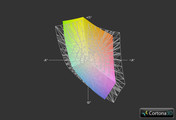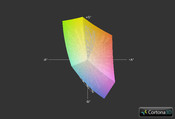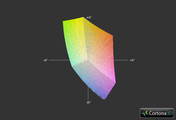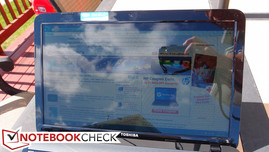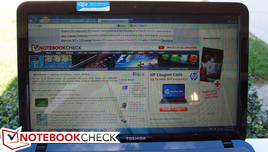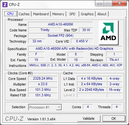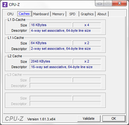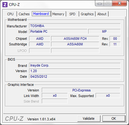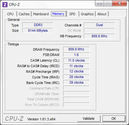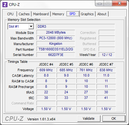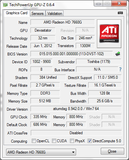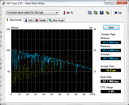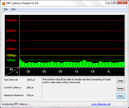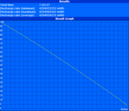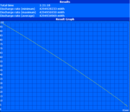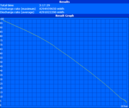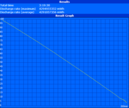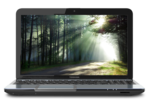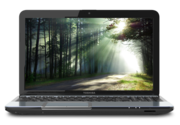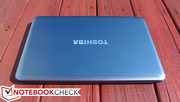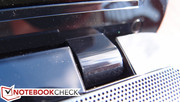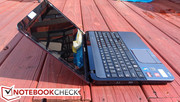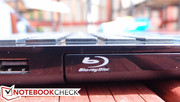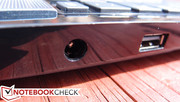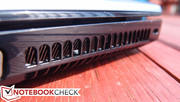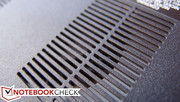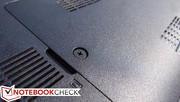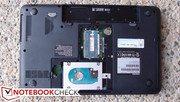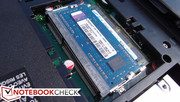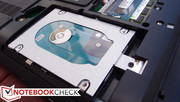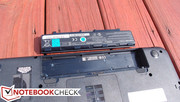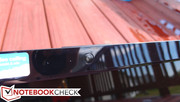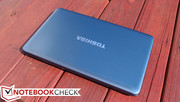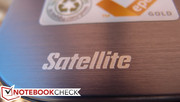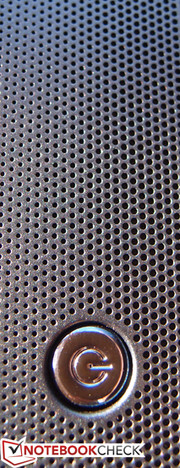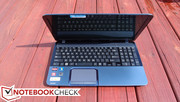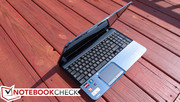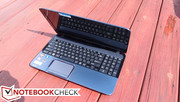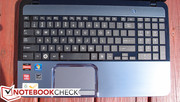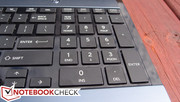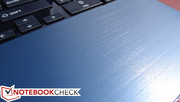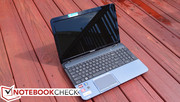Review Toshiba Satellite S855D-S5256 Notebook

Toshiba offers no fewer than four different 15.6-inch Satellite notebook varieties, each targeted at a slightly different market. At the bottom of the ladder, there’s the C Series, which provides only the essentials and is meant for those who are mostly concerned with price. Next comes the L Series, which steps up into mid-range performance with Intel Core i5 and AMD A8 APUs and integrated graphics. At the top end is the P series, which is crafted out of etched aluminum and features Intel Core i7 CPUs with either integrated or discrete graphics. And, finally, the S series—which is what we’re covering today with the S855D—is designed especially for those seeking a high-performance, entertainment-grade PC, but who wouldn’t mind compromising in just a few key areas in exchange for a lower cost.
Our Satellite S855D review unit includes an AMD A10-4600M quad-core APU with integrated Radeon HD 7660G graphics. Similarly-equipped models are available directly from Toshiba for around $700. As always, we subjected the notebook to a flurry of intensive tests, benchmarks, inspections, and comparisons. Grab a snack and let’s evaluate the S855D from top to bottom.
Case
Immediately obvious is the primary point of compromise chosen by Toshiba in its design of the Satellite S-series: the casing and construction. It isn’t bad, but it is almost entirely comprised of plastic, implementing metal only where aesthetics benefit most from its application.
The entire core of the notebook is built from hard plastic. The underbody, sides, and trim are all plastic as well. These parts of the notebook can be flexed under moderate pressure and don’t provide much reassurance that the machine could withstand any sort of rough treatment or a minor drop. The area underneath the optical drive and any of the underside vents feel like they could potentially crack if even just squeezed a bit too much. The only metal to be found is on the palm rest (a decision which undeniably provides a classy illusion of sturdy construction) and the back of the display lid. Like that of the palm rest, the thin metal coating on the display lid also looks very nice, but it lacks the rigidity necessary to truly provide any substantial degree of protection against LCD stress and breakage. In short, the S855D comes off as a pretty fragile machine.
Fortunately, the display hinges seem very capable, supporting the screen well with very little wobbling. And elsewhere, the positive side of this approach to construction is a lighter overall weight than many all-metal notebooks. Besides, sturdiness isn’t necessarily the goal of this notebook; rather, it is the compromise between construction and performance which Toshiba hopes will add up to an irresistible price tag.
Although there isn’t much room for upgrades (more on that in a bit), thankfully, the S855D also provides easy access to the most important replaceable components. The bottom of the notebook features a single panel cutout covering both hard drive and memory, secured by just a single screw and some fairly cooperative plastic clips. The LCD screen, meanwhile, is relatively easy to access and remove in the event of breakage. Like most Satellite notebooks, following the removal of four concealed screws, the bezel snaps off from around the perimeter of the panel.
Connectivity
The Satellite S855D offers a merely average selection of expansion ports for a 15-inch machine. You’ll find just three total USB ports, two of which are USB 3.0 and one of which is USB 2.0 with sleep and charge. Apart from that, there are the usual two video output options (HDMI and VGA), and the bare minimum elsewhere. It’s enough to get the job done, but certainly nothing generous.
Plus, in spite of the decidedly small number of ports overall, the vast majority of them are all crammed along the right-hand side of the notebook with very little room in between. It’s a strange design seeing as the opposite (left) side of the notebook has quite a lot of empty real estate available. Fortunately, one of the lone ports on the left side is the USB 2.0 port, meaning that any larger-than-usual USB devices can be banished to it, leaving room for the more reasonably-sized connectors on the right side.
Communication
Our Saltellite S855D review notebook includes a single-band Realtek RTL8723AE 802.11n wireless network adapter supporting up to 150 Mbps in a 1x1 antenna configuration. There’s also a built-in Bluetooth 4.0 adapter which comes standard using the Realtek chipset. It’s disabled by default, but is easily activated using the wireless function key (F12) on the keyboard.
The initial wireless driver for the Realtek 802.11n adapter (dated 1/10/12) exhibited problems connecting to some Wireless-N networks at full speed. For instance, our 300Mbps MIMO Wireless-N network was only yielding speeds of 54 Mbps to the S855D when first connected. However, a driver update to the latest version of the wireless driver on Toshiba’s website (dated 8/6/12) corrected this problem. Post-update, the adapter now correctly connects to Wireless-N networks at its maximum possible speed of 150 Mbps.
It’s worth mentioning that there are no PCI-e mini slots available on the Satellite S855D. That means that if you’re hoping to connect to a WWAN network, you’ll need to invest in an external USB adapter compatible with the carrier of your choice.
Accessories
Provided with the notebook is a small 65W AC adapter, and that’s it. Apart from the larger battery options, not much else is offered to expand the functionality of the Satellite S-series notebooks. One isolated exception is the Toshiba dynadock Universal Docking Station (of which there is a standard and USB 3.0 variety), but these have been poorly-received by customers due to complaints about inconsistent and unreliable operation. The bottom line is that if you’re hoping for a suitable docking station option, you’ll either want to invest in a business-grade laptop with a dedicated docking station port on the bottom or look elsewhere.
Warranty
The standard warranty included with every Satellite S855D is one year, parts and labor (including the battery). Optional warranty upgrades are available to be purchased separately, including extended warranties, on-site warranty service packages, and accidental damage protection.
Input Devices
Keyboard
The chiclet-style keyboard included on the Satellite S855D features well-spaced keys that are, for the most part, intuitively laid out. However, the performance of the keyboard is a different subject. Keypresses provide very little travel and exhibit a subtle feedback which provokes a sort of subconscious cliffhanger as to whether or not the input actually registered. In some cases, they actually didn’t, probably because fast-moving fingers can easily tap the rather large (and flat) trenches between each key without it feeling much different from an actual keypress. This presents a pretty serious issue for quick typists, as they’re likely to be thinking too much about the actual act of typing to be focused on whatever it is they’re working on. Compared to, say, a ThinkPad keyboard (whether classic or AccuType) or a Dell Latitude keyboard, wefound the Satellite S855D’s considerably harder to adjust to. Over time, however, users are likely to grow used to the idiosyncrasies of the design, and the challenges are likely to diminish somewhat.
There is a full-sized number pad to the right of the keyboard to please those predisposed to data entry work. Tiny arrow keys inhabit a single-key-height space just to the left of it (below the right Shift key), and they’re just as hard to operate as it looks, compounding the issue with a terribly muted feedback and soft press. Finally, there’s a bit of flex to the keyboard as well, though it’s difficult to notice in general use because the keyboard encourages softer typing with its design.
Touchpad
On the bright side, the excellent Synaptics touchpad is comfortably large and accurate. It's soft, matte finish facilitates an easy glide of the finger across its surface, and the two buttons below it are quiet but decisive in their operation, offering a definite click and feeling tight and well-affixed. The affiliated Synaptics touchpad software includes the usual swath of available options and customizations ranging from multi-finger gestures to multiple scrolling methods, and full control of nearly every associated parameter.
Display
The Satellite S855D features a brighter-than-average standard HD (1366x768) glossy display panel with subjectively attractive color reproduction. The level of saturation appeared comfortable but not overbearing. In spite of the disappointing black value and contrast ratio and the as-expected narrow viewing angles, the only real complaint we found with the display was the high-gloss finish, which limits its use in many brighter environments.
In terms of raw numbers, the panel’s average luminosity of 238 nits is only slightly betrayed by its brightness distribution of 82%; the center of the display is the brightest point (at 262 nits), and you have to really squint to notice much of a difference even in the darkest regions. It’s bright enough that even moderate brightness levels will likely please most users—average brightness is achieved at around level 6. Meanwhile, the black value of 1.86 is quite high, leading to a disappointing contrast ratio of just 141:1.
| |||||||||||||||||||||||||
Brightness Distribution: 82 %
Center on Battery: 262 cd/m²
Contrast: 141:1 (Black: 1.86 cd/m²)
52.5% AdobeRGB 1998 (Argyll 3D)
72.9% sRGB (Argyll 3D)
50.8% Display P3 (Argyll 3D)
The color spectrum coverage of the panel just about makes up for it, though, scoring a fairly decent 78% coverage of sRGB. While still a ways off from complete coverage of the spectrum, this is better than many low-budget TN panels, and the results are palpable in daily use. Our earlier impressions of the “attractive” color reproduction have this to thank. Compared to, for instance, the Dell Inspiron 14R-N4110, it’s easy to see the difference (as illustrated by the graph below).
As you might expect, in spite of the better-than-average brightness, outdoor use is only really practical in shaded areas. The glossy finish is highly reflective and produces notable obstructions any place where bright light is facing the screen—including indoors in front of windows and bright lights. However, in the shade, the notebook’s screen is perfectly tolerable.
Perhaps as expected, the merely average TN panel included in the S855D possesses the all-too-familiar narrow viewing angles. Moving anywhere close to the 45 degree mark in any direction produces notable color distortion and makes reading anything on the screen quite a challenge.
Performance
Although the S855 series of notebooks is available with both AMD and Intel offerings, our particular review unit included an AMD chipset. The AMD choices are the least expensive of the bunch, but it’s possible to select a processor as powerful as the Intel Core i7-3610QM if your budget allows. Each variation is denoted by a different suffix; our review model (specifically, the Satellite S855D-S5256) features a pseudo-quad-core (more on this in a moment) AMD A10-4600M APU, which leverages the latest platform from the chip maker, codenamed Trinity. Trinity introduces Turbo Core 3.0, which (like Intel’s Turbo Boost) provides an automatic overclock of the processor in situations where additional performance is warranted, provided there is thermal headroom available to accommodate it.
The A10-4600M has a base clock rate of 2.3 GHz and can automatically overclock all the way to 3.2 GHz when called for. With a TDP of 35W, the power consumption is also pretty reasonable. Earlier we mentioned that it is a “pseudo-quad-core” processor; what we mean by that is that it actually only includes two modules with four integer-cores and two floating-point cores. Moreover, the Turbo Core 3.0 functionality isn’t as effective as Intel’s Turbo Boost, though single-threaded performance is considerably better than the Llano precursors.
Arguably more interesting than CPU performance is the on-die Trinity GPU, which is considerably faster than any other integrated graphics solution. Each Trinity processor includes a different GPU—with the A10-4600M we received packing a Radeon HD 7660G. Again similar to Intel’s approach, this GPU scales its core speed based on the application, in this case with clock rates ranging from 497 to 686 MHz. The performance is comparable in most cases to that of a Radeon 6630M discrete graphics card—which is impressive. For more specific information on the performance of this processor in dozens of games and other benchmarks, don’t miss our special Trinity in Review: AMD A10-4600M APU article.
The 6 GB of DDR3 RAM in our system was reached by combining a Kingston 2 GB and a Samsung 4 GB SODIMM, both 1600 MHz (PC3-12800) speed. Up to 8 GB DDR3-1600 RAM is supported, which should be plenty for just about any application.
As always, we tested the system using DPC Latency Checker to assess its ability to stream audio and video without dropouts or stutters. Even with all wireless radios (Wi-Fi and Bluetooth) enabled, the DPC latency never rose far above 500 µs, which is excellent.
Processor
While it may not be of paramount importance to the average entertainment/gaming PC user, the A10-4600M’s actual CPU performance truly isn’t very good. It’s slower in most cases than even an Intel Core i3-2310M (Sandy Bridge, last generation), and much slower than equivalent Ivy Bridge processors. If single-core/older benchmarks are excluded, its performance appears more favorable, coming closer to the midrange Intel Core i5 Sandy Bridge CPUs. However, nothing rivals the newer Ivy Bridge offerings—especially those at the top of the ladder. Still, it would be silly to classify the CPU as sluggish, as it still zips through everyday tasks without any hesitation, and the powerful integrated GPU makes for a sometimes better combo than a comparable Intel chipset. It’s just that Intel’s CPU offerings are so much faster.
Thus far, the closest notebooks in terms of specs that have come through our offices have had their Trinity GPUs paired with an accompanying discrete GPU (namely, the HD 7670M). As such, it’s difficult to draw comparisons between the performances of the different models when the GPU speed has some bearing on the results. However, in terms of CPU only, we can compare with the Acer Aspire V3-551G-10468G50Makk and the HP Pavilion g7-2051sg, both of which yield nearly identical results in the Cinebench R10 and R11.5 CPU tests (the differences in scores between the three notebooks are negligible at generally less than 2%).
The performance of the GPU, on the other hand (which we’ll cover in much more detail later in our review) is impressive. It’s powerful enough to handle most games fluidly on medium (many even high) settings, and will please most users who plan to game on the go and don’t want to sacrifice the battery life associated with heavier-duty, power-hungry gaming notebooks. In terms of integrated graphics, it effortlessly sets a new standard.
As always, we reran a couple of benchmarks on battery power to ensure the notebook’s performance wouldn’t suffer. The scores didn’t budge materially versus their AC power counterparts in either 3DMark 05 (9858 on battery versus 9865 on AC) or Cinebench R10 64-bit multi-CPU (8168 on battery versus 8183 on AC), confirming that the notebook is perfectly suitable for heavy-duty use while unplugged.
System Performance
To help assess general overall performance of each system, we use PCMark synthetic benchmarks, which are adversely affected by any relevant bottlenecks (such as a weak CPU or a sluggish hard drive). The Satellite S855D turned in thoroughly average scores of 5373 and 1926 on PCMark Vantage and PCMark 7 respectively, suggesting that the notebook’s performance is in line with most lower-end Intel models, even some low-voltage CPUs. It’s certainly the CPU that is primarily to blame for this lower-than-desired score.
Still, as emphasized earlier, slowdown isn’t evident during everyday use. Subjectively speaking, the notebook seems perfectly capable as a primary machine, yielding only to CPU-heavy tasks such as video encoding. Similar to how many users have learned to accept low-voltage chipsets as suitable for everyday computing needs in exchange for a lighter-weight machine, so will many people find solace in the better-than-average GPU performance and lower cost of an AMD A10 notebook when considering their options. And, as is often the case with many so-called Ultrabooks (which generally feature the aforementioned low voltage CPUs), it’s a solid state drive (SSD) which can truly boost the perceived performance of a typical system.
| PCMark Vantage Result | 5373 points | |
| PCMark 7 Score | 1926 points | |
Help | ||
Storage Devices
Speaking of storage devices as bottlenecks, the Satellite S855D’s chosen hard drive is actually quite good for a 5,400 RPM model. Our review unit included a large TOSHIBA MQ01ABD075 750 GB 5,400 RPM hard drive. Since the system isn’t configurable, this is the only available option for this specific model (though, of course, brands and models may vary and are not explicitly stated on the specifications page).
This drive turns in a 76.7 MB/s transfer rate, which is actually a great score for a 2.5-inch 5,400 RPM drive. Still, since such better options are available in the way of 7,200 RPM models and SSDs, if you’re looking to upgrade something, this might be the first place to start. On the other hand, it does provide a ton of storage space, which is a plus if you’re planning on using the notebook for its intended purpose (an entertainment device, where likely plenty of large video would be involved).
Something which we found unnerving was a periodic “click” emitted by the drive that was quite audible indeed. This seems to occur at regular intervals and is difficult to ignore in a quiet room. The case design may be as much to blame as the drive itself in this instance, however, as the plastic panel on the bottom features a large vent just underneath the drive’s location near the front of the notebook that unintentionally functions like a down-firing speaker. In other words, when the notebook is located on a hard surface, the sounds of the hard drive are seemingly amplified by this design.
Gaming Performance
Although the Satellite S855D is classified as an entertainment notebook, it’s also perfectly capable of playing some games. That’s thanks to AMD’s new Trinity GPU, which promises performance close to many low- to mid-range discrete adapters. The Satellite S855D includes the top-end AMD mobile APU, which, as logic would suggest, is also paired up with the top-end integrated GPU: the Radeon HD 7660G. Though we’ve tested the GPU before in the past pretty extensively, we wanted to get an idea of how this particular model stacks up against our previous numbers.
We chose Blizzard’s latest, Diablo III, to see if the numbers matched those of our previous tests. Although the results weren’t congruent with our previous findings (possibly due to driver differences or other variations in testing), we were still extremely pleased with the performance of the 7660G, which was easily able to handle the game on any settings we threw at it. For instance, on High settings, which we define as 1366x768 resolution, Textures, Shadows, Physics, and Clutter Density all on High, and Anti-Aliasing On, the notebook still managed an excellent 41 frames per second.
| 3DMark 03 Standard | 20650 points | |
| 3DMark 05 Standard | 9865 points | |
| 3DMark 06 Standard Score | 7318 points | |
| 3DMark Vantage P Result | 4476 points | |
| 3DMark 11 Performance | 1147 points | |
Help | ||
| low | med. | high | ultra | |
|---|---|---|---|---|
| Diablo III (2012) | 56 | 42 | 41 |
Emissions
System Noise
The Satellite S855D fares quite well in the category of noise. While idle, it turns in a reasonable average score of 31.6 dB, with almost no deviation from that value. Under load, meanwhile, the noise rises to a median level of 34.9 dB, with a maximum of 38 dB—certainly audible, but far from disturbing. Further supporting its cause is an unobtrusively pleasant fan “whoosh” tone versus the whine of many other systems, as well as a general lack of pulsation and other irritating fan programming mishaps.
The only time the system becomes bothersome in its noise level is when the optical drive is at work; DVD playback and access noise levels come to 40.5 and 43.5 dB respectively. The Blu-ray drive in general just seems to be a rather noisy variety, probably covered by what is a very thin sheathing of hard plastic (at least, that area of the case flexes enough under pressure to support that theory).
Noise level
| Idle |
| 31.5 / 31.6 / 31.8 dB(A) |
| DVD |
| 40.5 / 43.5 dB(A) |
| Load |
| 34.9 / 38 dB(A) |
 | ||
30 dB silent 40 dB(A) audible 50 dB(A) loud |
||
min: | ||
Temperature
The Satellite S855D has little to be ashamed of in the area of heat. AMD chipsets have always been less efficient than their Intel brethren, but perhaps the previously-discussed quiet operation of the S855D also plays a part in occasionally higher-than-desired temperatures.
Fortunately, the heat is distributed in such a way that, even when under load, the notebook doesn’t become too uncomfortably hot to use. The top of the notebook never reached above 42.6°C in our testing, and that value was only found overtop the number pad area. The next highest reading was 40°C in the center of the keyboard. Meanwhile, the bottom of the machine heats up to 44.2°C in the center when stressed, a value which most people will not appreciate, but which is easily avoided by moving one’s legs to the sides of the notebook, where temperatures are noticeably cooler.
Idle use provides better numbers overall, but most of which are still much higher than that of competing notebooks with Intel chipsets. The top of the notebook still saw numbers hovering around 36°C, while the bottom reached a puzzling 38.4°C. None of these numbers are problematic from a typical usage standpoint, but there exist notebooks that idle at 5 to 10°C cooler than this model, so it’s still worth considering.
(±) The maximum temperature on the upper side is 42.6 °C / 109 F, compared to the average of 36.9 °C / 98 F, ranging from 21.1 to 71 °C for the class Multimedia.
(±) The bottom heats up to a maximum of 44.2 °C / 112 F, compared to the average of 39.2 °C / 103 F
(±) In idle usage, the average temperature for the upper side is 33.9 °C / 93 F, compared to the device average of 31.3 °C / 88 F.
(+) The palmrests and touchpad are reaching skin temperature as a maximum (34.2 °C / 93.6 F) and are therefore not hot.
(-) The average temperature of the palmrest area of similar devices was 28.7 °C / 83.7 F (-5.5 °C / -9.9 F).
Throttling
We leverage Prime95 and Furmark to impose maximal load on a system. Our prescribed testing here includes a CPU stress test, a GPU stress test, and finally, a combined stress test where both CPU and GPU are subjected to maximal load.
One of the improvements Trinity introduces is the ability to scale not only the CPU clock rate based on performance needs (which was already done in Llano), but also the GPU clock rate, provided there is thermal headroom available. It stands to reason that this should result in improved performance in many graphics-heavy applications, but the question remains, how effective is the performance when the system is under heavy load?
The Turbo Core 3.0 functionality seems to work most of the time as intended, but some of the observations were a bit puzzling. When the CPU only was stressed, only one of the four pseudo-cores actually remained near the base clock rate of 2.3 GHz; the others hovered closer to 2 GHz. Rarely did the clock rates even brush up against 2.7 GHz. When the GPU only is under stress, we observe all four cores running at 2.7 GHz (though in subsequent testing the clock rates jumped around more often). Meanwhile, the GPU clock rates fluctuate about as wildly as the CPU clock rates did in our CPU stress test. Thermals for both tests hovered between 65°C and 70°C.
Finally, under full system stress (GPU and CPU), we once again witnessed wild fluctuations in clock rates, with the CPU cores ultimately resting around a value of 1.6 GHz each. The GPU clock rate occasionally jumped to its maximum Turbo Core frequency of 686 MHz, but mostly remained at 497 MHz, which is the base clock rate. As you can see from the GPU-Z graph in the screenshot we posted, there were also periods where the GPU clock rate dropped below its base clock rate to around 335 MHz, which qualifies as throttling. However, again, this only seems to occur under very heavy system stress. Thermals once again remained near 70°C throughout all of this, occasionally rising slightly higher (at one point to nearly 75°C).
It’s not clear, but this inconsistent performance could either be due to suboptimal Turbo Core 3.0 implementation or Toshiba’s thermal design. Judging by an analysis of detailed log files, it does appear that most of the throttling occurred north of around 67°C, which may be close to the thermal ceiling set by the system firmware before throttling is employed. The fan, meanwhile, reportedly never ran at higher speeds than around 3,500 RPM. And as we mentioned earlier, the relative lack of noise supports that reading.
Speakers
The Satellite S855D’s speakers perform better than expected. While every notebook of its relative thinness are invariably lacking in low frequency response, the trebles are perfectly clear, and the volume is adequate. Stereo separation is notable and games and movies sound very good. There is some degree of flatness in the midrange, but it’s still pretty good for a notebook. This is an area which makes sense to have received attention considering the S855D’s marketed purpose as a budget entertainment notebook.
Battery Life
While it goes without saying that Trinity can’t compete with Intel’s Ivy Bridge architecture thanks largely to the 22 nm manufacturing process (versus Trinity’s 32 nm), it at least promises improvement over Llano’s numbers. We tested the Satellite S855D’s battery life under four vastly different scenarios of usage to see how it holds up under any range of conditions. Here’s what we found.
Our first battery test involves Battery Eater’s Reader’s Test. We disable all wireless radios, set brightness to minimum, change the power scheme to Power Saver, and disable all screen timeouts, dimming, hard drive power savings, and sleep/hibernation. Under these rather extreme power conservation settings, the Toshiba Satellite S855D lasted for 7 hours and 44 minutes before shutting down. This is a very encouraging figure, even if the conditions for the Reader’s Test are hardly practical. Next, we performed the Battery Eater Classic Test, which simulates heavy system load under High Performance settings with all wireless radios enabled. Under these conditions, the notebook lasted for just 1 hour and 21 minutes, a pretty average number.
The next couple of tests are probably the most interesting in terms of actual predictive value. For the first, termed our Real-World Test, we use Battery Eater’s Idle preset, set the power profile to Balanced, and then load a script which surfs the internet the way a typical user would, visiting sites ranging from standard articles on Notebookcheck to videos on YouTube. In this test, the notebook turned in a surprisingly subpar 3 hours and 17 minutes, which is below average. Finally, in our DVD test, we keep the same power settings and loop a DVD movie until the notebook gives out. In this test, the Satellite S855D endured 3 hours and 20 minutes until finally shutting down.
These battery life results aren’t remarkable, but they're still much better than what comparable Llano offerings provided. The Real-World Test result was a bit disappointing, but as with any test, they must be taken with a grain of salt. Your mileage may vary based on any number of factors, and the general consensus is that Trinity has made huge strides for AMD in terms of power efficiency, even if it still doesn't rival Intel's power consumption in most cases.
Verdict
Like its Satellite brethren, the Toshiba Satellite S855D is geared toward a very specific audience: those who want an entertainment notebook but aren’t willing to spend a fortune to get one. To that end, in most of the areas which truly matter to the intended market segment, it delivers acceptable results.
But it’s the compromises that give us pause, starting with the construction quality, which really is comprised of a lot of low-grade plastic. There’s a lot of flex and perceived weakness to the casing, and that instills a sense of excessive fragility. The metal trim on the palm rest and display lid is a nice touch, but it doesn’t add much of anything to the durability of the notebook beyond mere surface protection.
Beyond that, while gaming performance is the best we’ve seen from an integrated GPU, the processor performance is well below almost anything you’ll find on Intel’s side of the fence these days. The wireless adapter is unremarkable in its capabilities, and the limited number of ports feels inhibitive. Couple all of that with a subpar keyboard and an inconveniently glossy screen (albeit a bright one) and you have a puzzlingly average notebook with a price that does little to compensate.
Still, there is a market for this type of notebook, and it grows considerably as the price drops just a bit. On sale, it could be a seriously rational choice as a mobile entertainment and moderate gaming solution. But it’s a fiercely competitive market, and in the company of such opponents as the Acer Aspire V3-551G and even the slightly more expensive Dell XPS 15z, it’s a hard sell.













